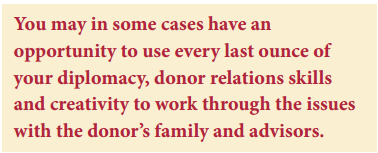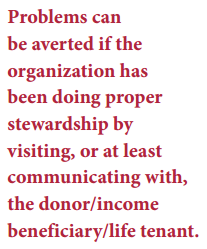In the last installment of this series, Sharpe Consultant Aviva Shiff Boedecker outlines some common problems that may be lurking beneath the surface of an estate gift and why your role as steward doesn’t end when the gift process is complete.
Things do not always go smoothly in the estate settlement process. A variety of challenges can arise after the donor’s death, and not all of them have clear solutions. You may in some cases have an opportunity to use every last ounce of your diplomacy, donor relations skills and creativity to work through the issues with the donor’s family and advisors, and you will sometimes have to bring in legal counsel. Some of the most common difficulties are outlined below.
Not receiving notice of a testamentary gift, although the donor said it was included in plans
When you do finally learn that your donor has passed away, if you have reason to expect a testamentary gift you will have to identify the person who is handling the estate to obtain copies of the will and/or trust agreement. Perhaps your organization was a contingent beneficiary or is still a successor beneficiary. It’s possible that the donor depleted his or her assets for living expenses—and it’s also possible that something is wrong.
Wills are public documents, so if necessary you can get a copy from the probate court, but trusts are not public. If you expected a gift but cannot obtain a copy of the trust agreement, do not hesitate to consult legal counsel. If you have a feeling that “something fishy’s going on,” there may be a larger problem than just your bequest. Call an attorney. Once an estate has been distributed there is very little you can do to recover the assets.
Not receiving notice of the beneficiary of a life income gift’s death
The beneficiary of a life income gift may have been your donor or may have been someone else who had no relationship to your organization. Once you have learned of the death be sure the trust administrator immediately stops making payments.


You may then have to work with the trust administrator to secure a refund of excess income distributions—never an easy situation. Whether the trust was administered by a third party or within your organization, be prepared to obtain outside legal support. Depending on the situation, you may have to file a claim against a third-party trust administrator.
Not receiving notice of a life tenant’s death
If you did not learn about the death of the last life tenant of a retained life estate, you will need to call on the services of an experienced attorney to help you get possession of the property and sort out what has been going on with it since the donor died.
Note that both of these problems can be averted if the organization has been doing proper stewardship by visiting, or at least communicating with, the donor/income beneficiary/life tenant on a regular basis.
Outstanding pledges
If the donor died leaving an unpaid pledge, your organization should file a claim against the estate within the statutory period. The administrator might pay the pledge without question, but if a claim is not filed the administrator may have no idea that there is an out standing pledge. either way, the administrator will need a basis for paying the pledge—he or she cannot simply make distributions from an estate because it is the right thing to do. Don’t wait, as there is a time limit on when claims must be filed, usually 60–120 days after the date of death, depending on the state.
When various types of pledges are legally enforceable against an estate, and when they are not, is beyond the scope of this article, but the matter should be discussed internally and perhaps with counsel.
Continuing stewardship
Good stewardship does not end with the distribution of the estate. It’s wise and appropriate to thank the estate’s attorney and the administrator for their work, and to write an additional thank you note to your donor’s family. Attorneys will appreciate the acknowledgment. They might (or might not) be interested in having a closer relationship with your organization, but in either case, maintaining a positive relationship may be helpful with future estates.
Keeping in touch with family about how the gift is used is a gracious touch. One or more family members might be interested in maintaining a relationship with your organization, or even in making additional gifts in memory of their loved one or on their own behalf. A cordial relationship with family is also useful if changing needs or circumstances might necessitate making a change in how the donor’s gift is used.
It’s not a happy thing when a beloved donor passes away, but remember—your donor cared enough to plan a testamentary gift, and it is the charity’s responsibility to make sure that it receives the intended sum and that his or her wishes are fulfilled.
In Part 5 of this series, we discuss the ins and outs of gifts received at death from sources other than bequests.

